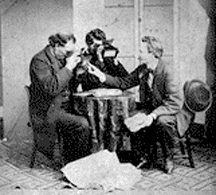
Victoria's Victoria: The Theatre Royal

|
|
Victoria's Victoria: The Theatre Royal |
|
A Look Inside the Theatre|Charles and Ellen Kean| Politics and Theatre| Local Theatre| Bibliography| |
The interior of the theatre was not only a hub of social activity, but also a reflection of colonial society.
| The Victoria Theatre
was a wooden proscenium arch theatre with a seating capacity of 600 people.
The proscenium arch, which was meant to give the stage a kind of picture
frame effect, had been introduced to the English stage by Indigo Jones in
the late 16th century, and most English theatres contained this innovation
by the Victorian era. There were eight sets of painted scenery, which
were to be used as needed in various productions, as was common on the London
stage. Moveable scenery was also a device introduced to England by Jones.
The addition of gas lighting was another manifestation of the British style,
as English theatres were predominantly lit by gas beginning in 1827. |
|

Men examining stereographic cards in the Victoria Theatre Photographic Gallery, early 1860s image courtesy BC Archives |
Upon entering the Victoria Theatre in 1861, audience members would have been astounded at what they saw. The exterior of the building did nothing to indicate the elegance which lay within. To the left of the wide entranceway was a ticket office, and to the right was a small room, apparently "intended as a fruit and cigar store." 1 The theatre was also equipped with a reservoir between the ceiling of the stage and the roof of the building, with a hose leading to a force-pump under the stage as a fire precaution. The risk of fire proved real in on June 25, 1861, when two fires broke out during a performance at the theatre. |
|
The seating in the Victoria Theatre was clearly indicative of
the class structure which existed in England as well as in Victoria
during this period. There was a gallery or dress circle, which
seated 200 people and comprised the most expensive seats, after
those located in the two private boxes on each side of the stage. The
parquet, which could seat 400 people, was divided into several gradations
of seats with varying prices. For example, at the rear, directly beneath
the dress circle, there was an area "for the accommodation of the colored
population." 2
This was known as the pit. The cushioned seats of the
theatre were perhaps another expression of British sensibilities, as comfortable
seating was often used by English theatre managers in order to attract
the more respectable members of society.3
The theatre was a place to see and be seen, as house lights were
not traditionally dimmed before the 1890s, and it was therefore an ideal
gathering place for members of Victorian society in both England and Victoria.
4
The audiences were known to become quite raucous at times, which
is perhaps a result of this desire for social attention at the theatre.
The upstairs dress circle, in which seats were "conveniently arranged
for an uninterrupted view of the stage"5
must have also given audience members an opportunity to display
their affluence to the lower classes seated below them. Located
behind the dress circle was a hall "suitable for a club or billiard room."
6
All of these factors pointed towards the theatre as a hub of
Victorian social life, as well as a reflection of the British class system. |
|
| In the fall of
1867, R.G. Marsh undertook the renovation of the Victoria Theatre.
The proscenium was rebuilt, the ceiling was frescoed, the boxes were widened
over the parquet, and new gas burners were installed for heat and light.
The newly renovated theatre was reopened as the Theatre Royal on October
10th, further affirming its connection with England and the monarchy.
For years, the theatre remained central to the society of Victoria; however,
in its later years it fell into a decrepit state and in October of 1882,
"the old building which in its day had echoed the deep, tragic tones of Charles
Kean, the gentle voice of Julia Dean Hayne and the 'smirks and grimaces'
of John Wood, was demolished to make room for the Colonist building."
7
|
|
|
Endnotes: 1.British Colonist, 22 December 1860. 2. British Colonist, 22 December 1860. 3. Gavin Weightman, Bright Lights, Big City : London Entertained 1830-1950 (London: Collins & Brown, 1992), 105. 4. Weightman, Bright Lights, Big City, 117. 5. Colonist, 17 May 1861, in Chad Evans, Frontier Theatre (Victoria: Sono Nis Press, 1983): 42. 6. Colonist, 17 May 1861, in Evans, Frontier Theatre: 42. 7. Souvenir program distributed at opening of the Theatre Royal (1885), in Daily Colonist, 26 July 1959. |
|
Charles and Ellen Kean : British Fame Visits Victoria Colonial Politics and the Theatre Return to the Theatre Royal : Main Return to Victoria's Victoria : Main |